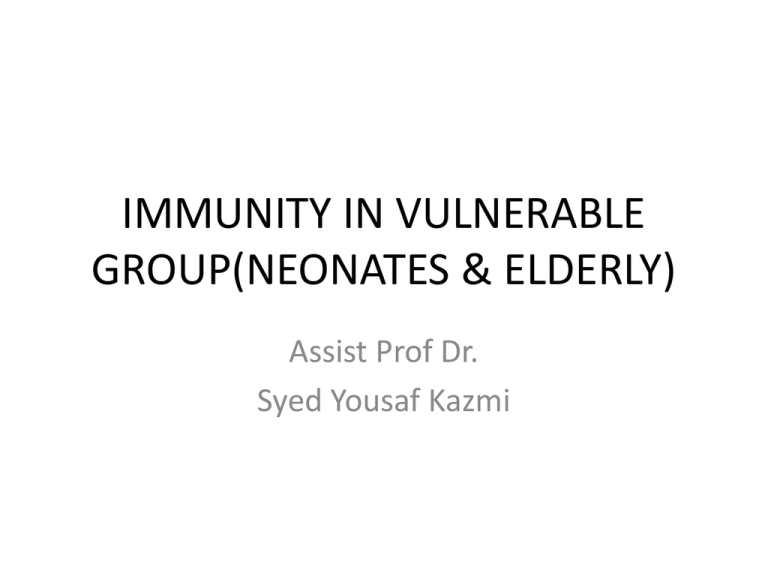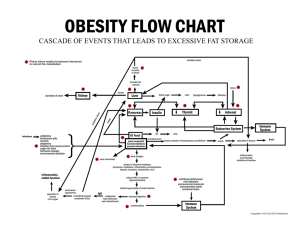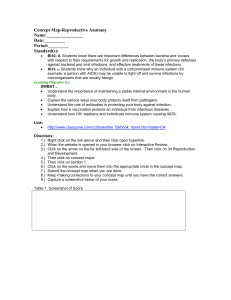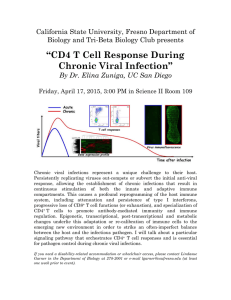Immunity in vulnerable age groups
advertisement

IMMUNITY IN VULNERABLE GROUP(NEONATES & ELDERLY) Assist Prof Dr. Syed Yousaf Kazmi OBJECTIVES • Discuss the immune status of neonates & elderly • Identify the common infections in these two age groups • Describe some of the preventive strategies IMMUNE STATUS IN NEONATES AND ELDERLY-GENERAL INTRO • Immune system is immature in neonates while it has waned in elderly • Both extremes of life are susceptible to infections • Elders have increase incidence of autoimmune disease, cancers and tolerance to transplants • Fetus lived in sterile environment-no past exposure to pathogen, no memory cells; face challenge • The neonate immune system is diminished in quantity & quality IMMUNE STATUS NEONATEINNATE ARM • Physical barriers are immature e.g. thin skin, low sebum production etc. • No microbial flora to guard against pathogens • Short length & small diameter of respiratory tree-easy access of pathogens • Plugging of respiratory tree by mucus-trap pathogens • Cough & sneeze reflex • Acid pH IMMUNE STATUS NEONATEINNATE ARM • Neutrophils , Macrophage, Monocytes have reduced functions in neonates • Chemotaxis-reduced • Neutrophils L-selectins reduced in number • ↓ Phagocytosis, Opsonization • ↓ complement (C9) predisposes to E. coli infection • Macrophage response to IFN- by activated T-helper cells is reduced-intracellular pathogens killing ↓ IMMUNE STATUS NEONATEADAPTIVE ARM • Humoral response in neonate is decreased • Secretion of cytokines decreased e.g. IL-4, IL-10 etc. • IgG and IgA responses to pathogens, although inducible, are relatively weak • Neonate is almost wholly dependent upon passive transfer of Immunoglobulin from mother IMMUNE STATUS NEONATEADAPTIVE ARM • During intrauterine life, tolerance to fetal allo-antigens due to immune hypo-responsiveness • Fetal immune system is directed to TH2 arm than TH1 (protect against placental & fetal damage) • Suppression of TH1 arm of immune system continues in neonate period • Cytotoxic T cell functions are diminished esp against viruses (e.g. RSV) than adult children INFECTIONS IN NEONATES NEONATAL SEPSIS Group B streptococci Escherichia coli Listeria monocytogenes Respiratory syncytial virus (RSV) Herpes simplex virus (HSV) Cytomegalovirus (CMV) Varicella-zoster virus (VZV) Candida species INTRAUTERINE INFECTIONS Toxoplasma gondii Others (Syphilis) Rubella Cytomegalovirus Herpes simplex virus NEONATAL CONJUNCTIVITIS Staph aureus UMBILICAL SEPSIS (OMPHALITIS) COMMUNITY ACQUIRED(3-6 wks) Streptococcus pneumoniae Streptococcus pyogenes AGE RELATED CHANGES IN ELDERLY • Poor cough/ sneeze reflex • Stiff respiratory cage • Poor mucociliary function • Prostate hypertrophy-urine stagnation • Replacement of red marrow with fat • Deteriorating function of multiple organs e.g. kidney, liver • Poor blood supply to peripheral tissue SHIFT OF IMMUNE STATUS IN ELDERLY • Decrease number of HLA class I and II antigenic sites on lymphocytes • Decreased proportion of T, B, cells • NK cells increased density per cell • Decreased number of monocytes • Decreased ability of dendritic cells to stimulate T-cell secretion of IFN and IL2 • Functional impairment of macrophages and granulocytes • Macrophages produce less IFN- IMMUNE STATUS OF ELDERLY B-CELLS FUNCTION • Decreased number of circulating and peripheral blood B cells • Decreased generation of primary and secondary memory B cells • General decline in lymphoproliferative capacity • General decrease in humoral responsiveness: • Decline in high affinity protective antibody production of Germinal center-site of B lymphocytes production IMMUNE STATUS OF ELDERLY T-CELLS FUNCTION • General decline in cell mediated immunity • T-cell population become hyporesponsive • Decline in new T-cell production • Increase in proportion of memory T-cells • Decrease in new T-cells production • Diminished functional capacity of new T-cells T cytotoxic cells attacking cancer cell INFECTIONS IN ELDERLY Increased incidence of following infections occur in elderly • E. Coli • Streptococcus pneumonia • Mycobacterium tuberculosis • Pseudomonas aeruginosa • Herpes virus • Influenza virus pneumonia • Reappearance of latent viral infections e.g. Varicella zoster PREVENTION OF INFECTIONS IN NEONATES & ELDERLY CARE OF NEONATES (DELIVERY) Deliveries carried out by expert midwives Observation of hand hygiene Observation of universal precautions/ barrier nursing Use of clean sterilized equipments in hospital/ labor rooms etc. ELDERLY PERSONS Geriatric care Care of old age related diseases Pharmacological management of old age diseases like BPH, DM etc. PREVENTION OF INFECTIONS IN NEONATES & ELDERLY IMMUNIZATION Follow EPI program of the country Old age specific immunization e.g. pneumovax, Influenza virus, etc. MANAGEMENT OF INFECTION Prompt identification of pathogen & appropriate treatment Use of microbiological lab (C/S testing etc.) INFRASTRUCTURE & TRAINING Strengthen public health infrastructures to support surveillance, response, and research to implement prevention and control of infections



